Competitive Bio-Accumulation Between Ammonia and Nitrite Results in Their Antagonistic Toxicity to Hypophthalmichthys molitrix: Antioxidant and Immune Responses and Metabolic Detoxification Evidence
Abstract
1. Introduction
2. Materials and Methods
2.1. Chemicals
2.2. Silver Carp Maintenance and the Exposure Protocol
2.3. Detection of Physiological and Biochemical Parameters in Plasma
2.4. Detection of Oxidative and Antioxidative Parameters in the Liver
2.5. Detection of Immune Parameters in the Spleen
2.6. Histological Evaluation
2.7. Total RNA Extraction and Transcriptome Sequencing
2.8. Real-Time Quantitative Real-Time Reverse Transcription PCR (qRT-PCR)
2.9. Statistical Analysis
3. Results
3.1. Hepatic and Splenetic Histopathology
3.2. Effects of Ammonia, Nitrite and a Combination of the Two on Antioxidative and Immune Responses
3.3. Effects of Ammonia, Nitrite and the Combination of the Two on Plasmatic Ion Concentrations and Nitrogen Metabolism
3.4. Transcriptional Characteristics
3.5. Functional Annotation and Classification of the Transcriptome
3.6. Verification DEGs Using qRT-PCR
3.7. IBR Indices
4. Discussion
5. Conclusions
Supplementary Materials
Author Contributions
Funding
Institutional Review Board Statement
Informed Consent Statement
Data Availability Statement
Conflicts of Interest
References
- Passell, H.D.; Dahm, C.N.; Bedrick, E.J. Ammonia modeling for assessing potential toxicity to fish species in the Rio Grande, 1989–2002. Ecol. Appl. 2007, 17, 2087–2099. [Google Scholar] [CrossRef] [PubMed]
- Chen, J.C.; Liu, P.; Lin, Y.T.; Lee, C.K. Super intensive culture of red-tailed shrimp Penaeus penicillatus. J. World. Aquacul. Soc. 1988, 19, 127–131. [Google Scholar] [CrossRef]
- Tacon, A.G.J.; Cdoy, J.J.; Conquest, L.D.; Divakaran, S.; Forster, I.P.; Decamp, O.E. Effect of culture system on the nutrition and growth performance of Pacific white shrimp Litopenaeus vannamei (Boone) fed different diets. Aquacult. Nutr. 2002, 8, 121–137. [Google Scholar] [CrossRef]
- Fan, B.; Li, J.; Wang, X.; Chen, J.; Gao, X.; Li, W.; Ai, S.; Cui, L.; Gao, S.; Liu, Z. Ammonia spatiotemporal distribution and risk assessment for freshwater species in aquatic ecosystem in China. Ecotoxicol. Environ. Saf. 2021, 207, 111541. [Google Scholar] [CrossRef]
- Cheng, S.Y.; Shieh, L.W.; Chen, J.C. Changes in hemolymph oxyhemocyanin, acid-base balance, and electrolytes in Marsupenaeus japonicus under combined ammonia and nitrite stress. Aquat. Toxicol. 2013, 130–131, 132–138. [Google Scholar] [CrossRef]
- Randall, D.J.; Tsui, T.K. Ammonia toxicity in fish. Mar. Pollut. Bull. 2002, 45, 17–23. [Google Scholar] [CrossRef]
- Cheng, C.H.; Yang, F.F.; Ling, R.Z.; Liao, S.A.; Miao, Y.T.; Ye, C.X.; Wang, A.L. Effects of ammonia exposure on apoptosis, oxidative stress and immune response in pufferfish (Takifugu obscurus). Aquat. Toxicol. 2015, 164, 61–71. [Google Scholar] [CrossRef]
- Guo, H.; Chen, S.; Ouyang, K.; Kuang, Y.; Yang, H.; Wang, Y.; Tang, R.; Zhang, X.; Li, D.; Li, L. Evaluation of ammonia nitrogen exposure in immune defenses present on spleen and head-kidney of Wuchang bream (Megalobrama amblycephala). Int. J. Mol. Sci. 2022, 23, 3129. [Google Scholar] [CrossRef]
- van Bussel, C.G.J.; Schroeder, J.P.; Wuertz, S.; Schulz, C. The chronic effect of nitrate on production performance and health status of juvenile turbot (Psetta maxima). Aquaculture 2012, 326, 163–167. [Google Scholar] [CrossRef]
- Xiao, J.; Liu, Q.Y.; Du, J.H.; Zhu, W.L.; Li, Q.Y.; Chen, X.L.; Chen, X.H.; Liu, H.; Zhou, X.Y.; Zhao, Y.Z.; et al. Integrated analysis of physiological, transcriptomic and metabolomic responses and tolerance mechanism of nitrite exposure in Litopenaeus vannamei. Sci. Total. Environ. 2020, 711, 134416. [Google Scholar] [CrossRef]
- Hu, Z.; Qi, C.; Lin, C.; Tang, R. Nitrite stress induces oxidative stress and leads to muscle quality decreased in Wuchang bream (Megalobrama amblycephala Yih) Juveniles. Water 2022, 14, 160. [Google Scholar] [CrossRef]
- Sun, H.; Lü, K.; Minter, E.J.A.; Chen, Y.; Yang, Z.; Montagnes, D.J.S. Combined effects of ammonia and microcystin on survival, growth, antioxidant responses, and lipid peroxidation of bighead carp Hypophthalmythys nobilis larvae. J. Hazard. Mater. 2012, 221–222, 213–219. [Google Scholar] [CrossRef]
- Motamedi-Tehrani, J.; Peyghan, R.; Shahriari, A.; Razijalali, M.; Ebrahimi, E. Combined effects of ammonia-N exposure and salinity changes on hematological and serum biochemical factors and thyroid hormones in Nile tilapia (Oreochromis niloticus). Heliyon 2024, 10, e29103. [Google Scholar] [CrossRef]
- Cao, J.; Mei, J.; Xie, J. Combined effects of hypoxia and ammonia-N exposure on the oxygen consumption, glucose metabolism and amino acid metabolism in hybrid grouper (Epinephelus fuscoguttatus♀ × E. lanceolatus♂). Vet. Res. Commun. 2024, 48, 1521–1531. [Google Scholar] [CrossRef]
- Chen, J.-C.; Cheng, S.-Y. Recovery of Penaeus monodon from functional anaemia after exposure to sublethal concentration of nitrite at different pH levels. Aquat. Toxicol. 2000, 50, 73–83. [Google Scholar] [CrossRef]
- Ha, N.T.K.; Huong, D.T.T.; Phuong, N.T.; Bayley, M.; Jensen, F.B. Impact and tissue metabolism of nitrite at two acclimation temperatures in striped catfish (Pangasianodon hypophthalmus). Aquat. Toxicol. 2019, 212, 154–161. [Google Scholar] [CrossRef]
- Welker, T.L.; Lim, C.; Yildirim-Aksoy, M.; Klesius, P.H. Susceptibility of channel catfish (Ictalurus punctatus) fed with dietary sodium chloride to nitrite toxicity. Aquacult. Nutr. 2011, 17, e892–e901. [Google Scholar] [CrossRef]
- Cheng, S.Y.; Lee, W.C.; Shieh, L.W.; Chen, J.C. Increased production and excretion of urea in the kuruma shrimp (Marsupenaeus japonicus) exposed to combined environments of increased ammonia and nitrite. Arch. Environ. Con. Tox 2004, 47, 352–362. [Google Scholar] [CrossRef]
- Lin, L.; Li, J.; Liu, J.; Zhuo, H.; Zhang, Y.; Zhou, X.; Wu, G.; Guo, C.; Zhao, X. Single and combined effects of ammonia and nitrite on Litopenaeus vannamei: Histological, physiological and molecular responses. Aquacult. Rep. 2024, 35, 102014. [Google Scholar] [CrossRef]
- Li, X.; Wang, L.; Dai, X. Combined effects of ammonia nitrogen, nitrite, salinity, and temperature negatively impact the growth, survival, physiological, and biochemical parameters, and hepatopancreatic structure of Litopenaeus vannamei. Aquaculture 2025, 596, 741845. [Google Scholar] [CrossRef]
- Zhang, Y.; Ye, C.; Wang, A.; Zhu, X.; Chen, C.; Xian, J.; Sun, Z. Isolated and combined exposure to ammonia and nitrite in giant freshwater pawn (Macrobrachium rosenbergii): Effects on the oxidative stress, antioxidant enzymatic activities and apoptosis in haemocytes. Ecotoxicology 2015, 24, 1601–1610. [Google Scholar] [CrossRef]
- Brazão, C.C.; Kracizy, R.O.; Dutra, F.M.; Oliveira, A.P.d.; Silva, R.I.d.; Ballester, E.L.C. Combined and isolated effects of ammonia and nitrite on Amazon River prawn Macrobrachium amazonicum (Heller, 1862) juveniles. Aquaculture 2021, 533, 736204. [Google Scholar] [CrossRef]
- Chen, J.C.; Chin, T.S. Joint action of ammonia and nitrite on tiger prawn Penaeus monodon postlarvae. J. World. Aquacul. Soc. 1988, 19, 143–148. [Google Scholar] [CrossRef]
- Li, Y.; Guo, H.; Ge, H.; Sha, H.; Wu, Y.; Zou, G.; Liang, H. A time-dependent interactive effect of nitrite and ammonia on inflammatory and immune response in the head kidney of silver carp (Hypophthalmichthys molitrix). Comp. Biochem. Physiol. Part C Toxicol. Pharmacol. 2025, 288, 110078. [Google Scholar] [CrossRef]
- Li, W.; Wang, S.; Li, J.; Wang, X.; Cui, L.; Chen, J.; Liu, Z. Antioxidative enzyme activities in the Rhodeinae sinensis Gunther and Macrobrachium nipponense and multi-endpoint assessment under tonalide exposure. Ecotoxicol. Environ. Saf. 2020, 199, 110751. [Google Scholar] [CrossRef] [PubMed]
- FAO. Food and Agriculture Organization of the United Nations; FAO: Rome, Italy, 2022. [Google Scholar]
- Sun, S.; Ge, X.; Zhu, J.; Xuan, F.; Jiang, X. Identification and mRNA expression of antioxidant enzyme genes associated with the oxidative stress response in the Wuchang bream (Megalobrama amblycephala Yih) in response to acute nitrite exposure. Comp. Biochem. Physiol. Part C Toxicol. Pharmacol. 2014, 159, 69–77. [Google Scholar] [CrossRef]
- Jiang, L.; Feng, J.; Ying, R.; Yin, F.; Pei, S.; Lu, J.; Cao, Y.; Guo, J.; Li, Z. Individual and combined effects of ammonia-N and sulfide on the immune function and intestinal microbiota of Pacific white shrimp Litopenaeus vannamei. Fish Shellfish Immunol. 2019, 92, 230–240. [Google Scholar] [CrossRef] [PubMed]
- Miao, L.H.; Lin, Y.; Pan, W.J.; Huang, X.; Ge, X.P.; Zhou, Q.L.; Liu, B.; Ren, M.C.; Zhang, W.X.; Liang, H.L.; et al. Comparative transcriptome analysis reveals the gene expression profiling in bighead carp (Aristichthys nobilis) in response to acute nitrite toxicity. Fish Shellfish Immunol. 2018, 79, 244–255. [Google Scholar] [CrossRef]
- Zhang, Y.L.; Zhang, H.L.; Wang, L.Y.; Gu, B.Y.; Fan, Q.X. Changes of ammonia, urea contents and transaminase activity in the body during aerial exposure and ammonia loading in Chinese loach Paramisgurnus dabryanus. Fish Physiol. Biochem. 2017, 43, 631–640. [Google Scholar] [CrossRef]
- Gao, X.Q.; Fei, F.; Huo, H.H.; Huang, B.; Meng, X.S.; Zhang, T.; Liu, B.L. Impact of nitrite exposure on plasma biochemical parameters and immune-related responses in Takifugu rubripes. Aquat. Toxicol. 2020, 218, 105362. [Google Scholar] [CrossRef]
- Guo, H.; Lin, W.; Wu, X.; Wang, L.; Zhang, D.; Li, L.; Li, D.; Tang, R.; Yang, L.; Qiu, Y. Survival strategies of Wuchang bream (Megalobrama amblycephala) juveniles for chronic ammonia exposure: Antioxidant defense and the synthesis of urea and glutamine. Comp. Biochem. Phys. C 2020, 230, 108707. [Google Scholar] [CrossRef]
- Corbett, P.A.; King, C.K.; Mondon, J.A. Application of a quantitative histological health index for Antarctic rock cod (Trematomus bernacchii) from Davis Station, East Antarctica. Mar. Environ. Res. 2015, 109, 28–40. [Google Scholar] [CrossRef] [PubMed]
- Li, X.; Li, F.; Zou, G.; Feng, C.; Sha, H.; Liu, S.; Liang, H. Physiological responses and molecular strategies in heart of silver carp (Hypophthalmichthys molitrix) under hypoxia and reoxygenation. Comp. Biochem. Phys. D 2021, 40, 100908. [Google Scholar] [CrossRef]
- Brooks, S.J.; Harman, C.; Hultman, M.T.; Berge, J.A. Integrated biomarker assessment of the effects of tailing discharges from an iron ore mine using blue mussels (Mytilus spp.). Sci. Total Environ. 2015, 524–525, 104–114. [Google Scholar] [CrossRef] [PubMed]
- Lin, W.; Guo, H.; Wang, L.; Zhang, D.; Wu, X.; Li, L.; Li, D.; Tang, R. Nitrite enhances MC-LR-induced changes on splenic oxidation resistance and innate immunity in male zebrafish. Toxins 2018, 10, 512. [Google Scholar] [CrossRef] [PubMed]
- Sun, S.; Ge, X.; Xuan, F.; Zhu, J.; Yu, N. Nitrite-induced hepatotoxicity in Bluntsnout bream (Megalobrama amblycephala): The mechanistic insight from transcriptome to physiology analysis. Environ. Toxicol. Pharmacol. 2014, 37, 55–65. [Google Scholar] [CrossRef]
- Qin, C.; Shao, T.; Wang, Y.-m.; Gong, Q.; Yang, Q.; Bu, P. Effect of ammonia-N on histology and expression of immunoglobulin M and component C3 in the spleen and head kidney of Pelteobagrus vachellii. Aquacult. Rep. 2017, 8, 16–20. [Google Scholar] [CrossRef]
- Sun, Y.; Wang, S.; Huang, Y.; Hong, Y.; Xu, D.; Jiang, C.; Huang, Z. Unraveling the molecular mechanisms of nitrite-induced physiological disruptions in largemouth bass. Aquaculture 2023, 580, 740320. [Google Scholar] [CrossRef]
- Wang, J.; Li, Y.; Wang, J.; Wang, Y.; Liu, H.; Bao, J. Selenium alleviates ammonia-induced splenic cell apoptosis and inflammation by regulating the interleukin family/death receptor axis and Nrf2 signaling pathway. Biol. Trace. Elen. Res. 2022, 201, 1748–1760. [Google Scholar] [CrossRef]
- Sinha, A.K.; Zinta, G.; AbdElgawad, H.; Asard, H.; Blust, R.; De Boeck, G. High environmental ammonia elicits differential oxidative stress and antioxidant responses in five different organs of a model estuarine teleost (Dicentrarchus labrax). Comp. Biochem. Phys. C 2015, 174–175, 21–31. [Google Scholar] [CrossRef]
- Zhou, X.; Zhuo, H.; Lin, L.; Zhang, Y.; Li, J.; Fu, S.; Wu, G.; Guo, C.; Liu, J. Apoptosis-stimulating protein of p53 (ASPP) participates in the regulation of apoptosis in Litopenaeus vannamei under ammonia-N and nitrite-N stress. Aquacult. Rep. 2024, 39, 102413. [Google Scholar] [CrossRef]
- Zhang, Y.; Liang, X.-f.; He, S.; Li, L. Effects of long-term low-concentration nitrite exposure and detoxification on growth performance, antioxidant capacities, and immune responses in Chinese perch (Siniperca chuatsi). Aquaculture 2020, 533, 736123. [Google Scholar]
- Shang, Z.H.; Huang, M.; Wu, M.X.; Mi, D.; You, K.; Zhang, Y.L. Transcriptomic analyses of the acute aerial and ammonia stress response in the gill and liver of large-scale loach (Paramisgurnus dabryanus). Comp. Biochem. Phys. C 2021, 250, 109185. [Google Scholar] [CrossRef]
- Zhang, T.; Zhou, Y.; Wen, H.; Ma, X.; Xu, D. Integrated analysis of physiological, transcriptome, and metabolome analyses of the gills in Solenaia oleivora under ammonia exposure. Ecotox. Environ. Safe. 2024, 271, 115949. [Google Scholar] [CrossRef] [PubMed]
- Cheng, C.; Su, Y.; Ma, H.; Deng, Y.; Feng, J.; Chen, X.-L.; Guo, Z. Nitrite-induced oxidative stress, histopathology, and transcriptome changes in the Mud Crab (Scylla paramamosain). Isr. J. Aquac.-Bamidgeh 2019. [Google Scholar] [CrossRef]
- Xu, Z.; Li, T.; Li, E.; Chen, K.; Ding, Z.; Qin, J.G.; Chen, L.; Ye, J. Comparative transcriptome analysis reveals molecular strategies of oriental river prawn Macrobrachium nipponense in response to acute and chronic nitrite stress. Fish Shellfish Immunol. 2016, 48, 254–265. [Google Scholar] [CrossRef]
- Wu, L.; Chen, Q.; Dong, B.; Han, D.; Zhu, X.; Liu, H.; Yang, Y.; Xie, S.; Jin, J. Resveratrol attenuated oxidative stress and inflammatory and mitochondrial dysfunction induced by acute ammonia exposure in gibel carp (Carassius gibelio). Ecotoxicol. Environ. Saf. 2023, 251, 114544. [Google Scholar] [CrossRef]
- He, Y.; Ouyang, K.; Yang, H.; Wang, L.; Wang, X.; Li, D.; Li, L. The impact of ammonia and microcystin-LR on neurobehavior and glutamate/gamma-aminobutyric acid balance in female zebrafish (Danio rerio): ROS and inflammation as key pathways. Sci. Total Environ. 2024, 920, 170914. [Google Scholar] [CrossRef] [PubMed]
- Zhang, C.; Ma, J.; Qi, Q.; Xu, M.; Xu, R. Effects of ammonia exposure on anxiety behavior, oxidative stress and inflammation in guppy (Poecilia reticulate). Comp. Biochem. Phys. C 2023, 265, 109539. [Google Scholar] [CrossRef]
- Jia, R.; Liu, B.L.; Han, C.; Huang, B.; Lei, J.L. The physiological performance and immune response of juvenile turbot (Scophthalmus maximus) to nitrite exposure. Comp. Biochem. Physiol. C Toxicol. Pharmacol. 2016, 181–182, 40–46. [Google Scholar] [CrossRef]
- Ruyet, J.P.-L.; Lamers, A.E.; Roux, A.L.; Sévère, A.; Boeuf, G.; Mayer-Gostan, N. Long-term ammonia exposure of turbot: Effects on plasma parameters. J. Fish. Biol. 2003, 62, 879–894. [Google Scholar] [CrossRef]
- Deane, E.E.; Woo, N.Y.S. Impact of nitrite exposure on endocrine, osmoregulatory and cytoprotective functions in the marine teleost Sparus sarba. Aquat. Toxicol. 2007, 82 2, 85–93. [Google Scholar] [CrossRef]
- Peng, R.B.; Le, K.X.; Wang, P.S.; Wang, Y.; Han, Q.X.; Jiang, X.M. Detoxification pathways in response to environmental ammonia exposure of the cuttlefish, sepia pharaonis: Glutamine and urea formation. J. World. Aquacul. Soc. 2017, 48, 342–352. [Google Scholar] [CrossRef]
- Lim, C.B.; Chew, S.F.; Anderson, P.M.; Yuenk, I. Reduction in the rates of protein and amino acid catabolism to slow down the accumulation of endogenous ammonia: A strategy potentially adopted by mudskippers (Periophthalmodon schlosseri snd Boleophthalmus boddaerti) during aerial exposure in constant darkness. J. Exp. Biol. 2001, 204 Pt 9, 1605–1614. [Google Scholar] [PubMed]
- Wang, Z.; Guo, X.; Tu, J.; Shi, X.; Gan, L.; Zhang, M.; Jiang, H.; Zhang, X.; Shao, J. Responses of Micropterus Salmoides under ammonia stress and the effects of a potential ammonia antidote. Animals 2023, 13, 397. [Google Scholar] [CrossRef] [PubMed]
- Zhang, M.; Song, P.; Jiang, H.; Li, M. The argininosuccinate synthetase can differentially regulate nitric oxide synthase in yellow catfish Pelteobagrus fulvidraco. Fish Shellfish Immunol. 2022, 127, 991–1000. [Google Scholar] [CrossRef]
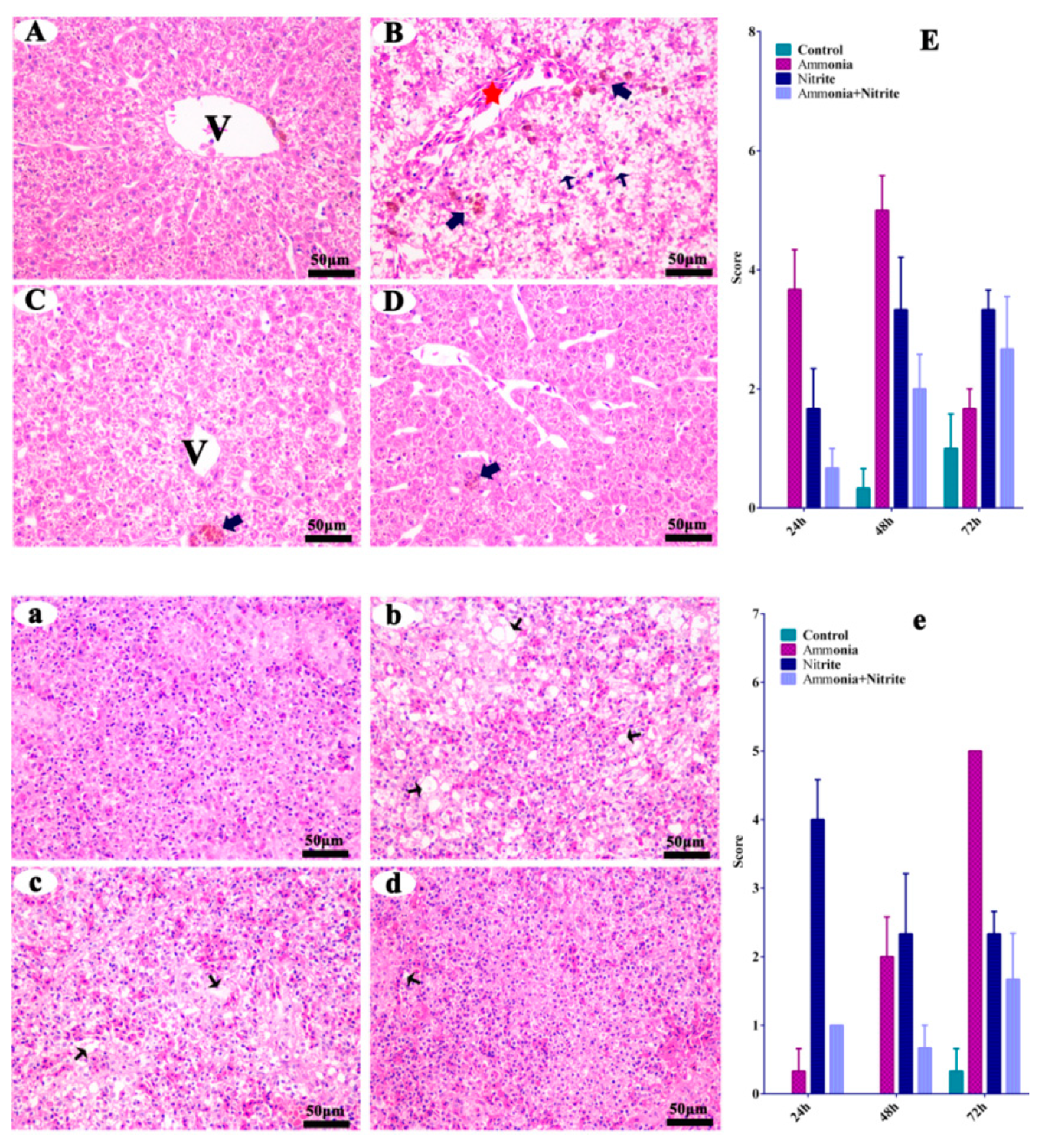
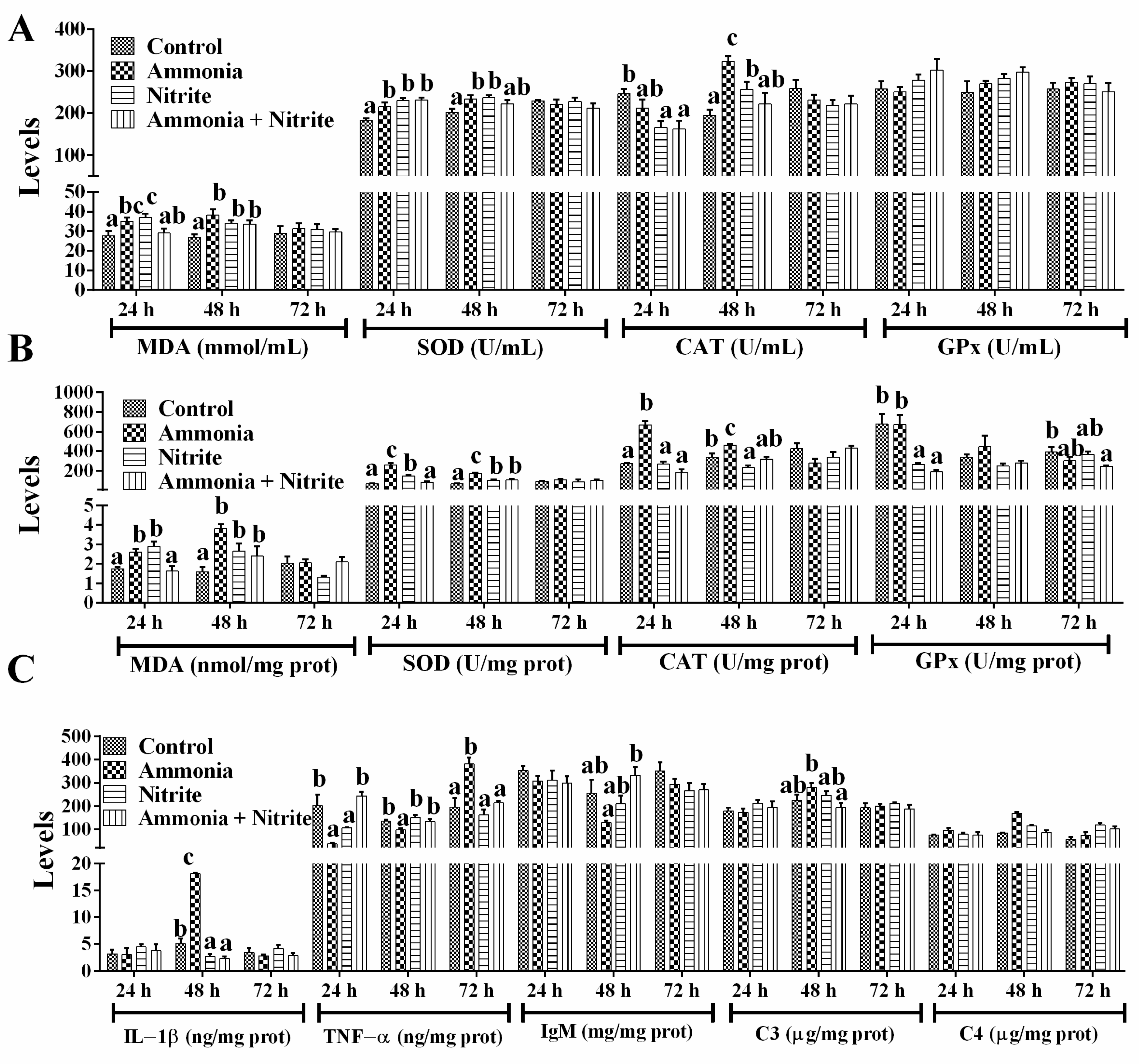
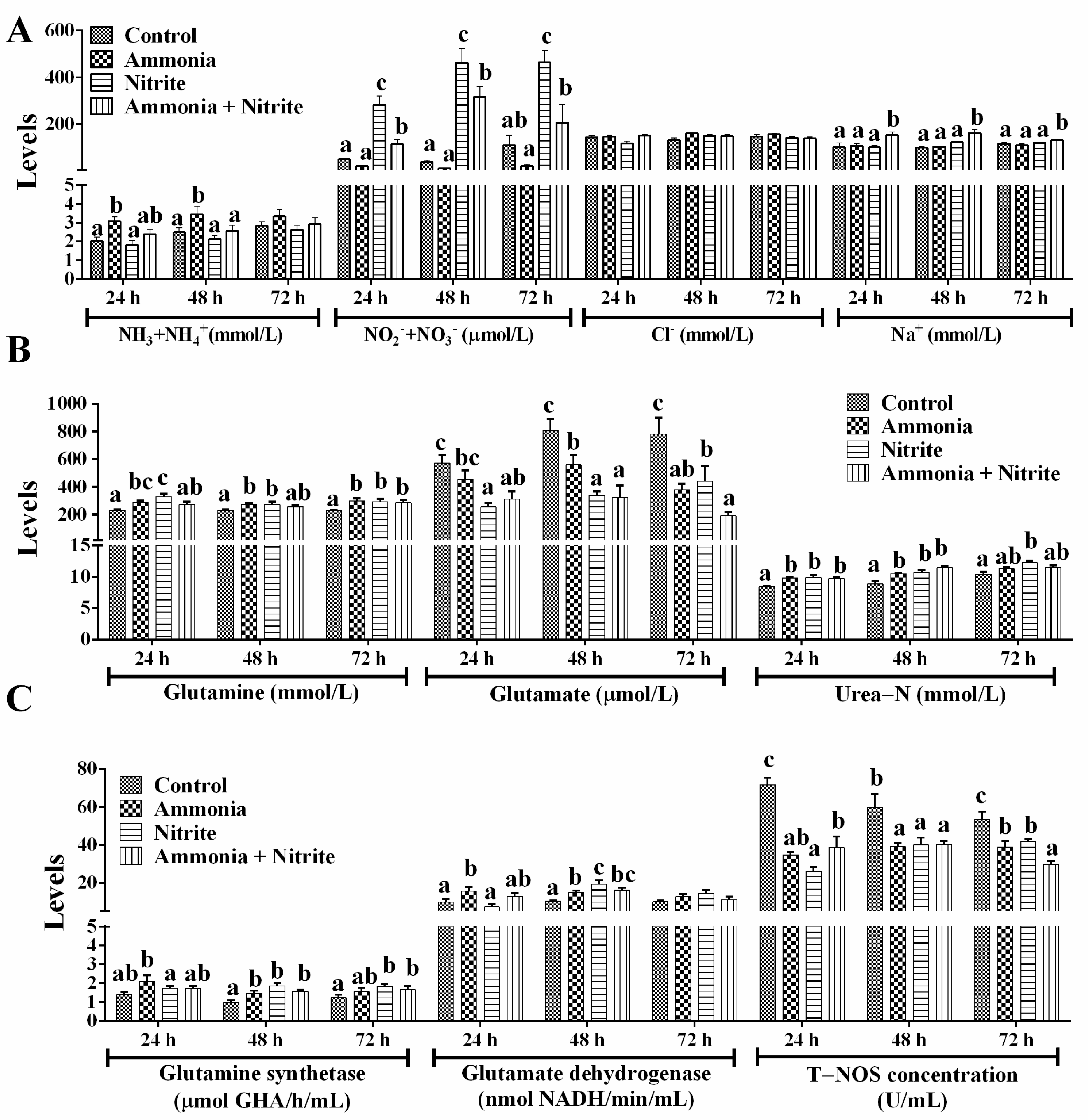
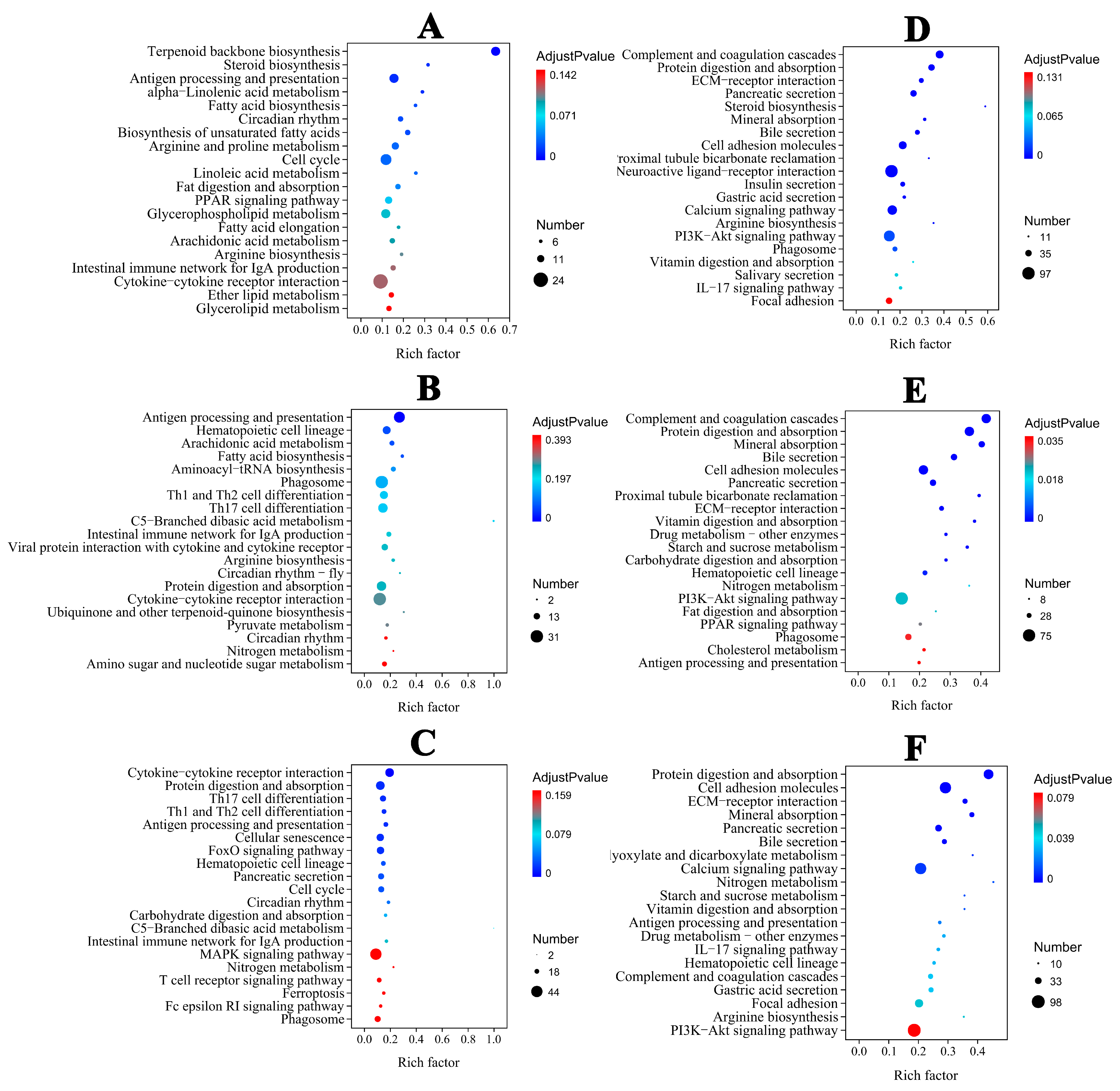
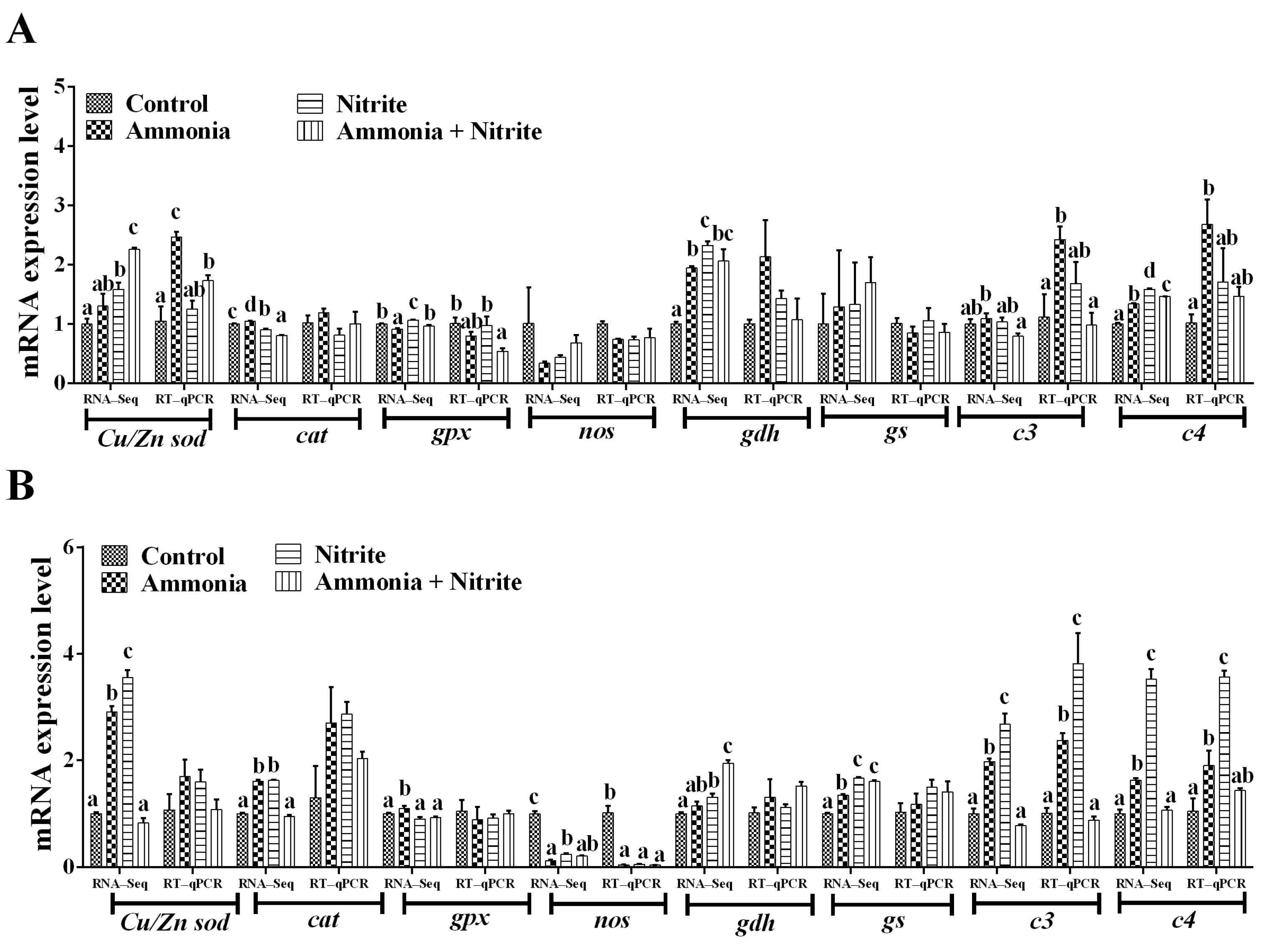
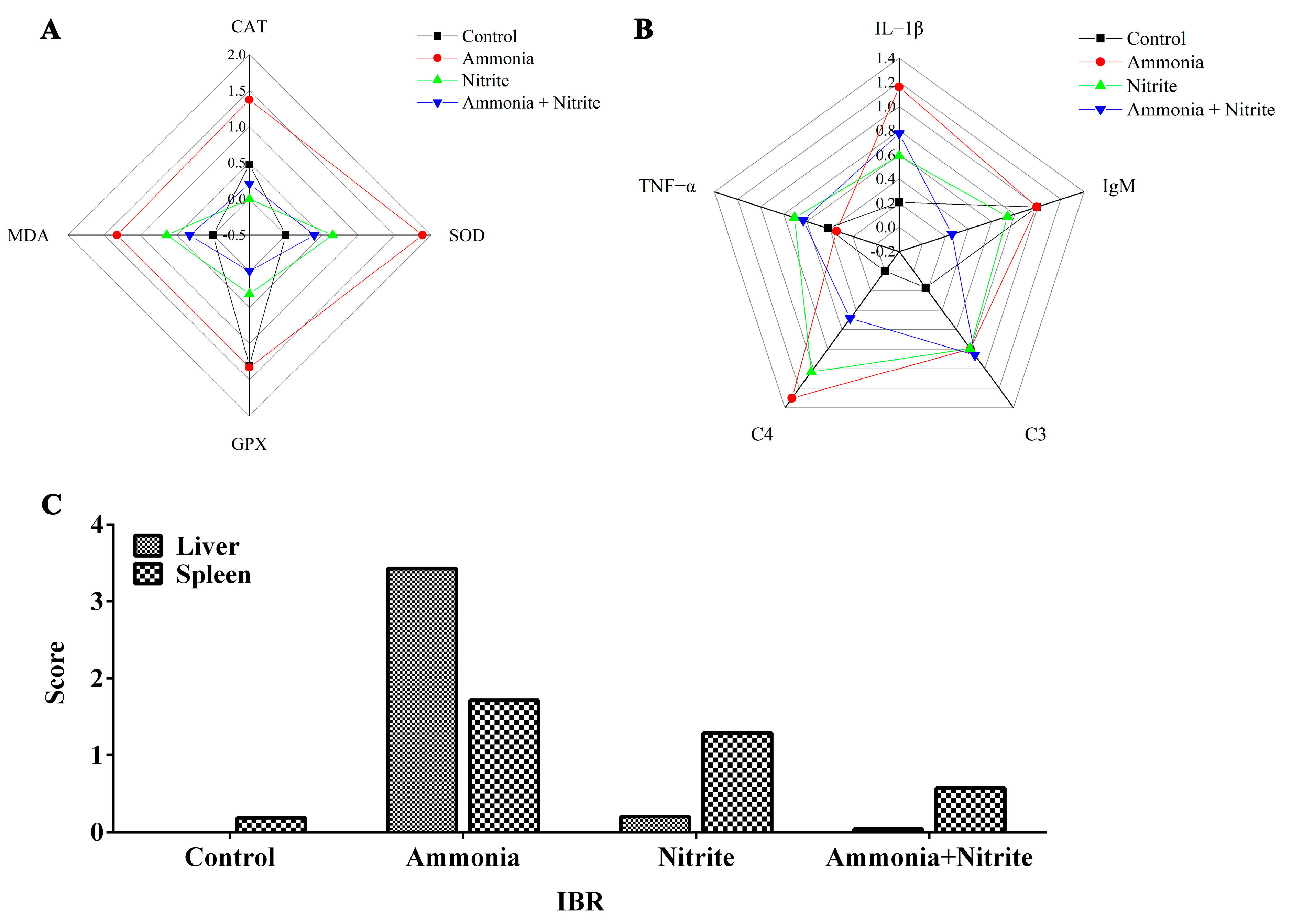
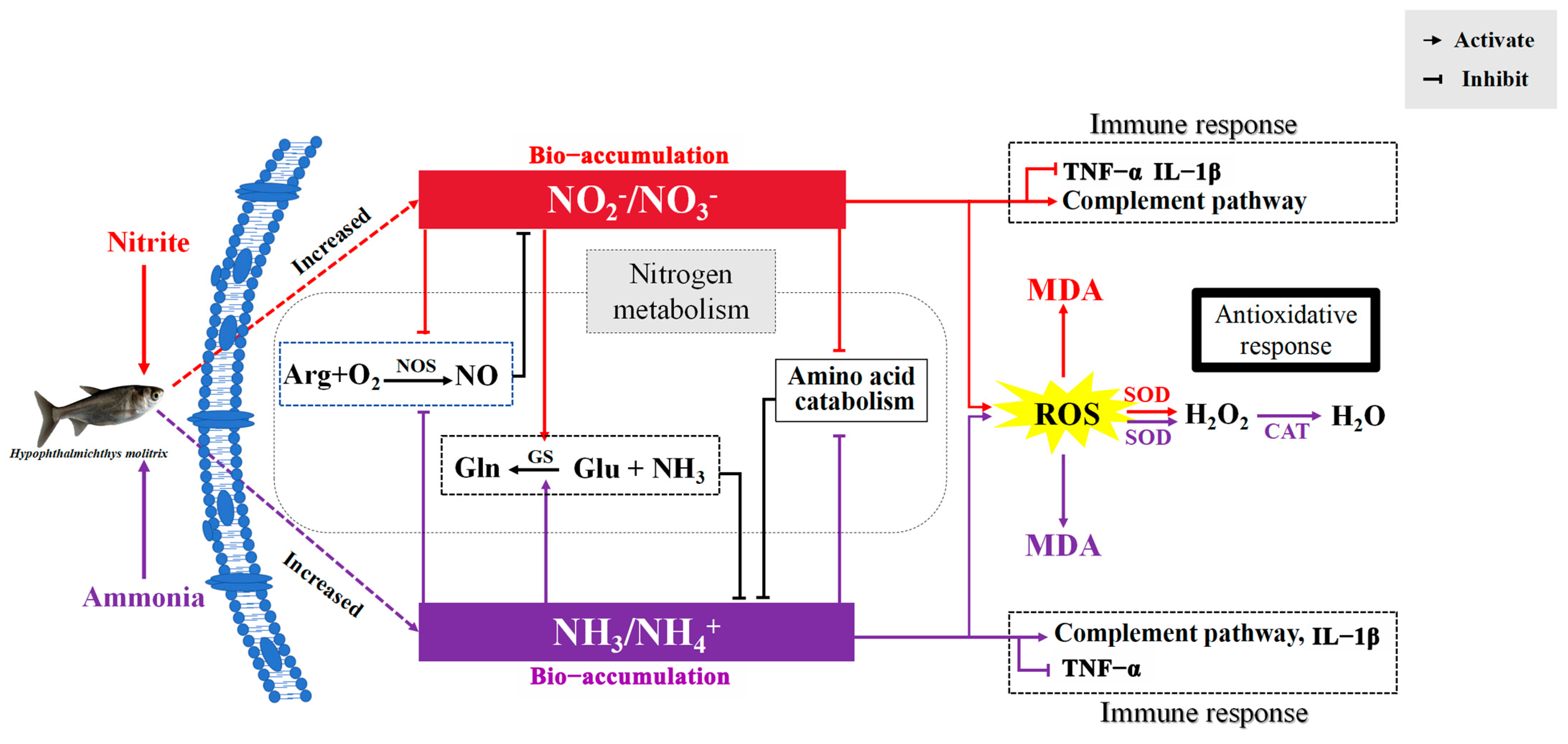
| Tissue | Parameter | Time | |||||
|---|---|---|---|---|---|---|---|
| 24 h | 48 h | 72 h | |||||
| F | p | F | p | F | p | ||
| Plasma | MDA | 12.289 | 0.002 | 7.694 | 0.012 | 0.447 | 0.511 |
| SOD | 5.246 | 0.033 | 6.952 | 0.016 | 0.194 | 0.664 | |
| CAT | 0.523 | 0.478 | 1.922 | 0.181 | 0.317 | 0.580 | |
| GPx | 0.694 | 0.415 | 0.023 | 0.882 | 1.269 | 0.273 | |
| Ammonia | 0.803 | 0.381 | 0.327 | 0.574 | 0.026 | 0.872 | |
| NO2−+NO3− | 10.169 | 0.005 | 2.317 | 0.144 | 2.761 | 0.112 | |
| Cl− | 0.357 | 0.557 | 2.459 | 0.133 | 4.305 | 0.051 | |
| Na+ | 3.16 | 0.091 | 4.079 | 0.057 | 6.305 | 0.020 | |
| Urea-N | 6.968 | 0.016 | 5.314 | 0.032 | 1.464 | 0.240 | |
| T-NOS | 44.290 | 0.000 | 5.882 | 0.025 | 0.242 | 0.628 | |
| Glutamate | 3.243 | 0.088 | 1.466 | 0.241 | 0.707 | 0.411 | |
| Glutamine | 12.724 | 0.002 | 5.005 | 0.037 | 4.399 | 0.049 | |
| GDH | 0.011 | 0.919 | 8.461 | 0.009 | 4.400 | 0.049 | |
| GS | 3.132 | 0.092 | 8.498 | 0.009 | 2.192 | 0.154 | |
| Liver | MDA | 27.632 | 0.001 | 2.813 | 0.132 | 0.120 | 0.738 |
| SOD | 88.546 | 0.000 | 28.956 | 0.001 | 0.001 | 0.972 | |
| CAT | 66.294 | 0.000 | 6.459 | 0.035 | 0.459 | 0.517 | |
| GPx | 0.227 | 0.646 | 0.415 | 0.537 | 0.183 | 0.680 | |
| Spleen | IL-1β | 0.070 | 0.797 | 138.794 | 0.000 | 0.327 | 0.583 |
| TNF-α | 34.671 | 0.000 | 0.956 | 0.357 | 6.575 | 0.033 | |
| IgM | 0.344 | 0.574 | 10.303 | 0.012 | 0.974 | 0.352 | |
| C3 | 0.093 | 0.769 | 6.998 | 0.033 | 1.337 | 0.285 | |
| C4 | 2.473 | 0.154 | 62.041 | 0.000 | 2.231 | 0.174 | |
Disclaimer/Publisher’s Note: The statements, opinions and data contained in all publications are solely those of the individual author(s) and contributor(s) and not of MDPI and/or the editor(s). MDPI and/or the editor(s) disclaim responsibility for any injury to people or property resulting from any ideas, methods, instructions or products referred to in the content. |
© 2025 by the authors. Licensee MDPI, Basel, Switzerland. This article is an open access article distributed under the terms and conditions of the Creative Commons Attribution (CC BY) license (https://creativecommons.org/licenses/by/4.0/).
Share and Cite
Guo, H.; Li, Y.; Ge, H.; Sha, H.; Luo, X.; Zou, G.; Liang, H. Competitive Bio-Accumulation Between Ammonia and Nitrite Results in Their Antagonistic Toxicity to Hypophthalmichthys molitrix: Antioxidant and Immune Responses and Metabolic Detoxification Evidence. Antioxidants 2025, 14, 453. https://doi.org/10.3390/antiox14040453
Guo H, Li Y, Ge H, Sha H, Luo X, Zou G, Liang H. Competitive Bio-Accumulation Between Ammonia and Nitrite Results in Their Antagonistic Toxicity to Hypophthalmichthys molitrix: Antioxidant and Immune Responses and Metabolic Detoxification Evidence. Antioxidants. 2025; 14(4):453. https://doi.org/10.3390/antiox14040453
Chicago/Turabian StyleGuo, Honghui, Yiwen Li, Heng Ge, Hang Sha, Xiangzhong Luo, Guiwei Zou, and Hongwei Liang. 2025. "Competitive Bio-Accumulation Between Ammonia and Nitrite Results in Their Antagonistic Toxicity to Hypophthalmichthys molitrix: Antioxidant and Immune Responses and Metabolic Detoxification Evidence" Antioxidants 14, no. 4: 453. https://doi.org/10.3390/antiox14040453
APA StyleGuo, H., Li, Y., Ge, H., Sha, H., Luo, X., Zou, G., & Liang, H. (2025). Competitive Bio-Accumulation Between Ammonia and Nitrite Results in Their Antagonistic Toxicity to Hypophthalmichthys molitrix: Antioxidant and Immune Responses and Metabolic Detoxification Evidence. Antioxidants, 14(4), 453. https://doi.org/10.3390/antiox14040453






